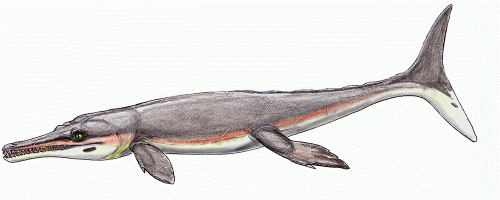Tooth structure and wear provide clues to ecology and evolution of ancient marine creatures

A trio of published studies have highlighted the importance of examining dental structure and wear in ancient creatures to better understand their ecology and evolution.
New York Institute of Technology College of Osteopathic Medicine Assistant Professor Brian Beatty, Ph.D., contributed to all three of the studies with his expertise in analyzing patterns of tooth wear and structure.
"Tooth wear is a permanent record – it shows the interaction of the animal and the world," says Beatty, a paleontologist who teaches anatomy to more than 300 medical and health professions students. "By examining the adult structure of teeth, we can learn how different vertebrate groups have been able to modify aspects of their tooth development so they can achieve structures that serve functional purposes."
Beatty says the findings in the three papers he contributed to may change perceptions of how some marine creatures lived in ancient times.
In the Zoological Journal of the Linnean Society, Beatty and colleagues from Brazil, Edinburgh, Scotland, snd the Museum of Jurassic Marine Life in Dorset, England, described a new species of ancient crocodile that had uniquely large sets of two different types of jaw muscles, enabling it catch and kill prey quickly with both speed and power. The study's first author is Mark Young from the University of Edinburgh's School of Geosciences.
Beatty also found that the skull of the dolphin-like species known as Torvoneustes ("savage swimmer"), was noticeably different than other creatures it is usually compared to. Most crocodiles have large bumps and pits in their skulls; Torvoneustes had a smooth skull that was lighter and reduced turbulence, which likely made it an agile swimmer, with movements more akin to a dolphin.
"These features we described could be another side of how extremely specialized these marine crocodiles were getting," says Beatty.
In a paper published in the Netherlands Journal of Geosciences, Beatty and colleagues, including first author F.M. Holwerda, studied the teeth of a small lizard-like species known as mosasaur. The researchers found that the …-million-year-old creature had a different feeding pattern than that associated with most lizards. Rather than grabbing prey and swallowing it, this species was more likely a bottom feeder, feasting on hard-shelled crabs, clams, and sea urchins along sandy areas beneath the sea.
The third paper, published in Acta Palaeontologica Polonica, details the unique anatomy of the teeth of Teleosaurids, another group of crocodile-like marine creature that lived about 165 million years ago. Beatty and his colleagues, including first author Young, described new findings about "denticles" or tooth-like projections similar to serrated surfaces in their teeth and visible only through scanning electron microscopic analysis. Closer examinations of the teeth, he said, mean that the creature perhaps had a larger role in its ecosystem beyond "being a croc simply snapping at things," Beatty said.
"The findings of the three papers confirm that the interactions of marine vertebrates in the past with each other and with their environment were just as complex as they are now," says Beatty. "Superficial resemblances do not define an animal's lifestyle – the beauty of evolution is this diversity and you see how natural selection drives evolution. There are situations where animals are deriving new organs, tissues, and molecules and they're doing that to deal with problems posed by natural selection. "
Beatty is one of six paleontologists in the College of Osteopathic Medicine's Department of Anatomy. He and Associate Professor Matthew Mihlbachler launched the online Dental Microwear Image Library containing thousands of magnified images of tooth surfaces that other scientists can use to establish hypotheses about ecological conditions in prehistoric times.
More information: Young, M. T., De Andrade, M. B., Etches, S. and Beatty, B. L. (2013), "A new metriorhynchid crocodylomorph from the Lower Kimmeridge Clay Formation (Late Jurassic) of England, with implications for the evolution of dermatocranium ornamentation in Geosaurini." Zoological Journal of the Linnean Society, 169: 820–848. DOI: 10.1111/zoj.12082. ZooBank registration: urn:lsid:zoobank.org:pub:4FFB975F-7568-4C16-BCDC-46ED96E25092
F.M. Holwerda, B.L. Beatty & A.S. Schulp. "Dental macro- and microwear in Carinodens belgicus, a small mosasaur from the type Maastrichtian." Netherlands Journal of Geosciences, www.njgonline.nl/publish/artic … /000535/english.html
Mark T. Young, Brian L. Beatty, Stephen L. Brusatte, and Lorna Steel "First evidence of denticulated dentition in teleosaurid crocodylomorphs." Acta Palaeontologica Polonica 28 Oct 2013. doi:dx.doi.org/10.4202/app.00002.2013
Journal information: Acta Palaeontologica Polonica
Provided by New York Institute of Technology


















